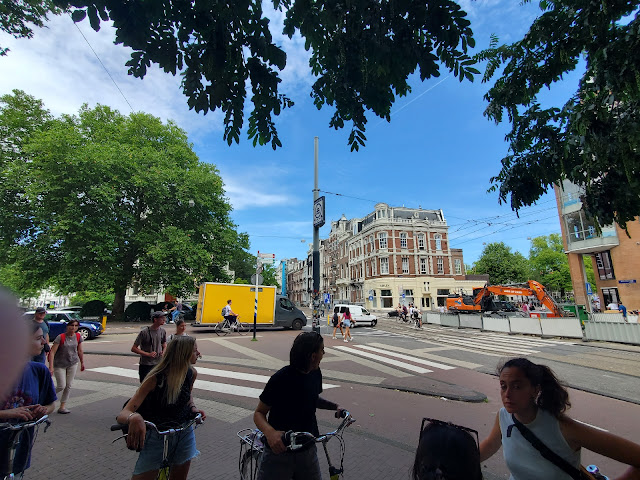Touring Copenhagen with Copenhagenize
On our last day in Copenhagen, the group visited a local urban planning and design firm, Copenhagenize. The presenter and tour guide, James, originally came from Toronto but mentioned living in Stockholm and Copenhagen over the past decade. His presentation reviewed some of the concepts we had already learned both from other lectures and bike tours, such as the infrastructure types that I had seen throughout the city (i.e., cycle tracks and the curb ramps that help one enter bicycle lanes). However, I appreciated the extended level of detail provided about the typology of infrastructures. For example, the group learned how the infrastructure aligned with the relationship between speed limits for cars and where the bicycle lanes existed. When cars traveled at the slowest speed, about 10 mph, the road is most often shared between cars and bikes, with no discerning infrastructure for bicyclists. At driving speeds of 20 mph, one sees bicycle lanes painted on the road with no physical barrier between the two modes. At a speed of 30 mph, then the design requires a separated cycle track that provides bicyclists their own designated lane and road space. At the highest speeds, such as 35 mph and faster, the design calls for installing a fence or creating any hard, physical barrier between the road and the dedicated cycle track to ensure the bicyclists are separated from the car traffic.
 |
| An island in the road for pedestrians and bicyclists to wait for traffic to pass |
 |
| The "Kissing Bridge" in Copenhagen; supports bicyclists & pedestrian traffic and serves as an important connector between residential areas and the central city |
Another valuable takeaway from James’ presentation was the
financial impact of promoting more cycling transportation within the city of
Copenhagen. One instance is the relatively low cost of installing bicycle
infrastructure compared to the significant cost of infrastructure projects such
as roadway bridges or paving, and maintaining, new roads that support cars.
Furthermore, James described a study conducted to assess the net financial
impact of bicycling for transport compared to automotive transport. The study’s
conclusion estimated that each bicyclist contributed a net gain of $0.65 to the
public system while the automobile commuter contributed a net loss of $0.71 to
the public system. This finding really hit home with me and I couldn't help but
think, “A capitalist would not be able to deny such a clear financial benefit
of the cost-benefit analysis presented.”
Beyond the monetary element, I walked away from the presentation with another insightful conclusion that James drove home. When discussing a vision with people, and especially those individuals that appear resistant to changing the roadway to be less supportive of driving and more of biking, the argument must emphasize the benefits to the person and neighborhood: improved air quality, a safer street for one’s children, and reduced noise. Benefits exist for the people that do not intend to switch transport modes. Supportive infrastructure for biking functions to support the entire community and does not exist as a basic one-to-one trade-off between better for bicyclists at the detriment of car driving.
 |
| The bicyclist stops slightly ahead of the car stop to bring the bicyclist out of the driver's "blind spot" |




Comments
Post a Comment